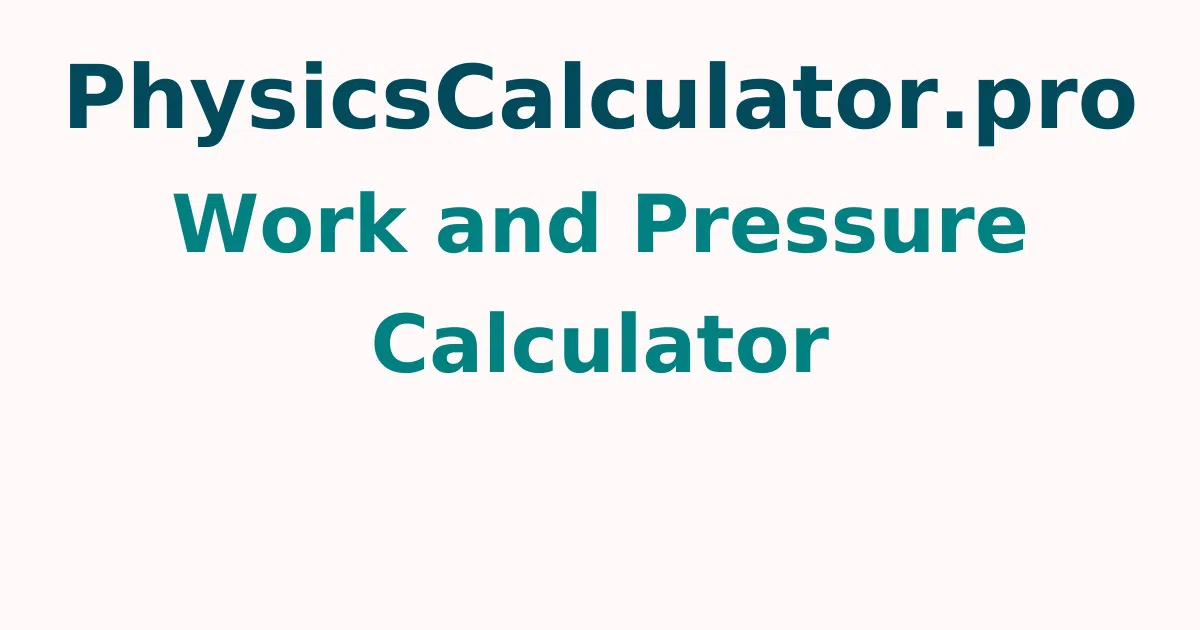Work and Pressure Calculator
The work and pressure calculator developed by us helps to determine the work done and the pressure faced by the object simultaneously under the constant force of motion on the object. All you need to do is provide the needed inputs and click on the calculate button to get the Work and Pressure in seconds.
What is meant by Work and Pressure?
Work, in physics, is defined as the measure of energy transfer that occurs when an object is moved over a particular distance by an external force acting on it, at least part of which is applied in the direction of the displacement of the motion.
And the pressure is defined as the physical force exerted on an object. The force applied is perpendicular to the surface of objects per unit area of the force applied. The fundamental formula defined for pressure is F/A (Force per unit area). With its unit as in Pascals (Pa).
Work and Pressure Equations
In physics calculations, to calculate work we need an object to move as a result of a force applied to it. The work equation (or the work definition) is W = F * d
- Where, W is defined as the work done;
- F is defined as the force applied to the object; and
- d is defined as the distance about which you moved the object.
Pressure is defined as the force applied perpendicular to the surface of an object at rest per unit area over which that force is distributed with respect to the object. Pressure can be calculated by the force per unit perpendicular area over which the force is applied i.e. p = F/A
- Where : P stands for pressure;
- F stands for the force and,
- A stands for the area covered by the object.
Types of Pressure
Absolute Pressure: It is the type of fundamental pressure that takes the place of vacuum or air-free space as the relative reference. This type of pressure changes generally as the location of the object changes since there is a change in the atmospheric pressure differences according to the reference point.
Gauge Pressure: Gauge pressure is the regraded as the difference between absolute pressure and atmospheric pressure. Gauge pressure is also known as relative pressure in problems related to aero and hydrodynamics. The measured pressure is compared to the standard atmospheric pressure at sea level.
How to use the Work and Pressure Calculator?
The work and pressure calculator developed by us is very simple and efficient to use.
- In its basic form, the user simply needs to input the force and the distance from your question, followed by the area covered by the object.
- It will automatically calculate the result accurately and in a very short span of seconds, when you once you click on it to proceed in the calculator.
For more concepts check out physicscalculatorpro.com to get quick answers by using this free tool.
Solved Examples on finding Work and Pressure
Example 1:
A water glass sitting on a table weighs 4 N. The bottom of the water glass has a surface area of 0.003 m^2. Calculate the pressure the water glass exerts on the table.
Solution:
Force or thrust here is F= 4 N
Area A = 0.003 m^2
The pressure exerted is defined as F/A
Hence substituting the values we get,
4/0.003 Pa
Hence we get, 1333.33 Pa
Example 2:
A student weighs 600 N. The student’s shoes are in contact with the floor over a surface area of 0.012 m^2. Calculate the pressure exerted by the student on the floor?
Solution:
Force or thrust here is 600 N
Area A = 0.012 m^2
The pressure exerted is defined as F/A
Hence substituting the values we get,
600/0.012 Pa
Hence we get, 5 x 10^4 Pa
FAQs on Work and Pressure Calculator
1. What is work in physics?
Work is defined as the energy transferred to or from an object through the application of force along with a displacement.
2. What do you mean by power in physics?
Power means work (J) per unit time (s). The SI unit for power is the watt (W)
3. What is pressure in physics?
The pressure is defined as, the perpendicular force per unit area, or the stress at a point within a confined fluid.
4. What is the formula for pressure?
Pressure is the force per unit perpendicular area over which the force is applied, which means p = F/A.
5. What are the two types of pressure?
There are two basic pressure types in physics these are, - absolute and gauge pressure.
